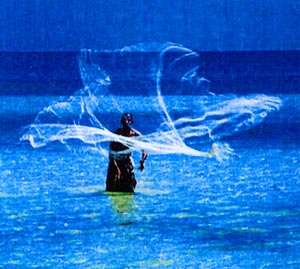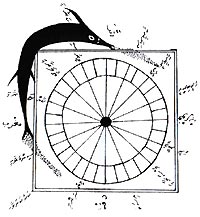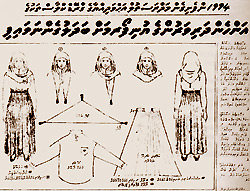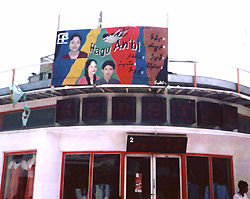THE
MALDIVE ISLANDERS, A Study of the Popular Culture of an
Ancient Ocean Kingdom.
Price:
Euro 18 plus postage. Postage is 9 Euro outside of India.
Contact NOVA ETHNOGRAPHIA INDICA: ethnoind@hotmail.com
| INTRODUCTION
| EPILOGUE
|
VILLAGES
IN THE OCEAN
In the
low, lush tropical coral islands of the Maldivian Atolls,
villages were located in the middle of the island. Owing
to their independent spirit, Maldivians used to build their
homes in a haphazard way about the island. Thick coconut
groves and other vegetation encircled the human settlements,
so that no house would be seen from the sea. The only constructions
with a 'beachview' would be makeshift sheds for boatbuilding
or boat- repair and lonely 'ziyarat' shrines.1
There
are a number of reasons for hiding human settlements. Traditionally
Maldivians didn't think that it was good for a person to
look too much at the sea, because one's 'heart would turn
to stone'. This sentence, in Divehi means that one would
lose one's memory2 and become absent-minded, finding it difficult to concentrate
on, for example, reading, and not that one would become
merciless.
Furthermore,
many trees didn't grow well if the salt-spray hit them directly.
Therefore, the first barrier of resilient3 bushes growing close to the waterline and the second barrier
of coconut trees, would effectively protect the more salt-sensitive
plants growing in the interior of the island, like bananas,
papayas and breadfruit trees. For the same reason, paths
were narrow and winding, and the point where a path met
the beach was considered an important geographical feature
in the Maldivian settlement pattern.
Such
points were called fannu in Divehi, the language
of the Maldive Islands, and they were like the 'gates' or
'mouths' through which the village inside the island opened
itself to the sea. People went to the waterline with a purpose.
Men would go to the sea to fish, girls would go to the beach
to scrub pots, all people would go regularly to answer calls
of nature, and sometimes boys would go there to play. However,
unless there was a necessity to go there, people would stay
as much as possible in their villages inside the island.
The
interior of the islands back then was a green, pleasant
and cozy place, admirably described by H.C.P. Bell when
he visited the Maldives in 1922:
"'A
thousand trees towards heaven their summits rear' making
of the clean-kept peaceful roads "with leafy hair overgrown",
cool umbrageous "cloisters", almost continuous in their
extension. Houses there are in plenty, but so well embowered
and hidden by sheltering fences and skilful adaptation,
as to give the effect of a somewhat close-set rustic village;
with little suggestion of regular streets and habitations
(...) to mar the picturesque peaceful tout ensemble. In
roads, gardens, houses --no matter what or where-- "order
in most admired disorder" rules.4
However,
during the nineteen-forties, the self-contained world of
the Maldive islanders experienced a terrible shock. Mohamed
Ameen Doshimeyna Kileygefaanu, who ruled first as regent
(since 1944) of an absentee Radun5
and then as President of the first Republic he proclaimed
(in 1953, the last year of his rule), decided to build new
avenues in the islands. The drive was allegedly to 'give
a modern façade' to the country. However, given Mohamed
Ameen's highly militaristic inclinations, it was probably
a counter-insurgency measure (of preventive character, as
there was no insurgency within the country back then). Having
studied in Europe, the new ruler had knowledge of modern
warfare and introduced many reforms in the Maldivian military.
Mohamed
Ameen introduced leader cultism in the islands. He was the
first Maldivian leader that displayed himself wearing a
soldier's uniform: his portrait (see illustration) had to
be displayed in every office, public buiding and school
throughout the Maldive Islands. His desire was to have an
avenue in every island to stage parades where he himself
would be leading his modernized army. Soldiers were given
khaki uniforms to replace the ancient black-and-white feyli
waistcloth they used to wear.
Under
the direct supervision of Mohamed Ameen, the entire Maldivian
population, in every island of the country, was ordered
to work in the construction of wide, straight streets. They
were traced criscrossing every island from beach to beach
and many valuable trees were sacrificed in the process.
The punishments for any islander shrinking from work were
unduly harsh, as these avenues had to be built in record
time. Special government officers were dispatched to every
important island in order to check that the work was advancing
at a fast pace.
Thus,
menfolk were not allowed to go fishing and spent their days
working hard, felling and uprooting trees, digging and carrying
earth from one place to the other. Since no modern machinery
was used in the process, conscripted workers had to use
their bare hands or rudimentary small tools. Island people
said those were terrible times, that womenfolk and children
went hungry for lack of fish. I met the widow of a man who
was killed, tortured to death, in a punishing cell made
especiafly for those who disobeyed government orders and
went fishing or to gather coconuts to feed their families.
The number of people who died in those circumstances was
never recorded.
Islanders
failed to understand the rationale behind such broad streets
going literally from nowhere to nowhere and allowing the
deadly salt-spray to enter right into the heart of the island.
Traditionally, the paths within islands were winding and
shady and, according to the islanders it was a pleasure
to walk on them. Those paths were also winding, not only
to avoid the salt-spray, but also to hamper the movements
of certain evil spirits that moved in straight lines, like
the malevolent spirits of the dead ancestors (kaddhovi).6
However,
mostly, people were sore for having to sacrifice so much
badly needed good soil and the cool shade and the fruits
of different kinds the trees could offer. All individual
islands in the Maldives are very small (the largest being
barely 5 sq/km) and the total land surface of the whole
archipelago lies around a mere 300 sq/km. Considering that
there is so little of it, it is hardly surprising that land
is so precious in the Maldives. Therefore, practically all
Maldivians, except for a few staunch supporters of their
charismatic leader, Mohamed Ameen, considered the broad
avenues to be a pointless waste.
The
traditional pattern of urbanization was brutally disrupted
too. Maldive villages which had been originally clusters
of homesteads, every house auspiciously aligned towards
the proper orientation determined by the nakatteryaa
or astrologer, became long alignments of houses stretched
along the new avenues. All this had, and is still having,
unforeseen traumatic effects upon the vitality of the Maldivian
island society and many of those adverse effects have not
even been fathomed. The reason being that the traditional
position of the house and the orientation of its door in
relation of the cardinal points had a paramount influence
on social organization and attitudes.7
The
new streets had to be fringed on both sides by coral walls.
Thus, much sand, lime and coral stones were needed. The
new homesteads delimited by walls, increased peoples privacy
and did away with the custom of walking from one house to
the other through the spaces between house proper and kitchen.
This area was known as medugoti in most of the Maldives
and as medovatte in the southern end of the country.
Shaded by plantains, drumstick trees or fruit trees, the
medovatte was where Maldivians, who used to live
outdoors sharing the company of their neighbors, spent most
of their life.
Most
men and women in the Atolls claim that the new urban disposition
led to the exacerbation of island rivalries and to the loss
of community life. Many also blame the general growth of
pride, demoralization and selfishness among islanders to
the privacy and isolation of walled-in compounds. Thus,
much of the island social fabric was destroyed by such an
apparently harmless action as building new streets.
After
the traditional urbanization pattern was callously disregarded
and swept away by Mohamed Ameen, no one has come up with
an alternative idea. This misguided plan is, even now, the
only blueprint existing for island urbanization in the Maldives.
Therefore, the local Island and Atoll Offices throughout
the country keep still opening new straight, broad avenues
and enforce the building of walIs8 lining them, exactly as in Ameen's time.
In
1985, one teacher in Meedhoo, Addu Atoll, an island crisscrossed
by a broad, desolate and surrealistic looking avenue, glaring
white in the harsh tropical midday sun, told me that most
of his island's people thought walls were useless and didn't
see the point in building them. As coral stones and lime
were becoming rare, they were making a sacrifice to build
the walls, considering that some of their own little houses
were not even walled, but thatched. He concluded by saying
that the government "doesn't realize how poor some people
are."
All
these evils could have been avoided if the common people's
opinion had been valued or respected. Mohamed Ameen is now
considered to be a great leader in the official Maldive
propaganda. He is called 'The Great Modernizer.' However,
his methods were feudal: to build his avenues, all able
men in each island were recruited to do forced labor and
were not allowed to attend to their families. Every morning
the island men had to go to the empty space close to the
government office and stand in ranks. Then, at eight o'clock
they marched towards the road-building sites.
Anyone
who reported late, was beaten with a stick. One man said
that he had been given many lashes when he had been very
late. If someone refused to come he would be locked in a
small, stinking cell. Even though the actual republic was
proclaimed only in 1953, the last year of Mohamed Ameen's
rule, all those years are known as 'Jumhuri Duvahi'
(the days of the republic) in the collective memory of Fua
Mulaku people. According to one islander9
who lived through those times:
'When
we had to open the new avenues in our island, many of those
streets cut straight through marshy ground. Thus, we had
to bring sand and gravel from the beach in baskets to the
working sites. We also had to uproot the stumps of very
large trees. We used iron rods and ropes. Work was very
hard and we came back hot and exhausted. If we would have
been fishing or climbing coconut palms, we would have been
exhausted too, but at least we would bring fish or palm-sap
home. Now we were arriving home empty-handed. Many children
would die because of this. We were getting so little food
that we were forced to eat papaya stems, plantain roots
and different kinds of leaves.
The
men who worked were given very little, and bad food. Not
like the food you get at home. My neighbor was jailed after
he had been unloading sugar sacks from a vedi (trading
ship). He was so hungry he pulled a little bit of sugar
from one end of the sack with his finger. He was seen licking
his fingers by a supervisor and was reported. Then he was
brought to the kosi (jail) straight away. His wife,
an aunt of mine, went to plead to the authorities for his
release, but was rudely sent back home under threats. Prisoners
were given almost no food, they couldn't get the customary
daily bath and were given no medical treatment. Thus, my
neighbor died after a few months.
'When
we washed him for burial, we saw that his body was full
of horribly infected, stinking wounds. He was not the only
one to suffer that fate though, as many more people died
in that jail. A lot of women and children died of hunger
during those days too, sitting silently in their homes.Their
husbands were not able to bring any food home and they were
too terrified to complain to the authorities.
'We
didn't know why all this was happening to us. We were not
informed properly of anything. They said that there would
be less mosquitoes on the island, but we didn't understand
what all that heavy work had to do with insects, and anyway
there were the same amount of mosquitoes, if not more, afterwards.
Our old people, racking their brains for an explanation,
said: "Mohamed Ameen is the friend of the Englishmen. He
wants to kill us all and give our islands to them,10 so they will come here with their cars and lorries. That
is why he makes us build those avenues.'
Mohamed
Ameen is still a controversial figure in the Maldives and
his ten years of iron-fisted rule disgusted many islanders.
However, he had, and still has, a group of fervent supporters.
According to Koli Hasan Maniku, a local historian, his tenure
was a 'one-man-show.' On the one hand, he introduced necessary
reforms, but on the other hand, his contempt for the plight
of the common man in hard times earned him fierce enemies
all over the islands. It cannot be denied that he had a
vision for the future of his country, but he adamantly disregarded
advice and lacked the necessary imagination to adapt development
policies to the needs of the Maldive Islands. Thus, his
modernization campaign was perceived by the islanders to
be a brutally carried out implementation of his personal
whims and fancies.11
Last,
but not least, Mohamed Ameen showed the same contempt towards
autochtonous customs that Arab 'holy men', exalted to undeserved
high positions, had displayed throughout Maldivian history.12 The period of his rule is remembered as a long and difficult
decade by most islanders who had to live through it.13 Southerners claim that his harsh and insensitive policies
disgusted them with the central government. Therefore, it
is not unlikely that this resulting discontentment led,
less than one decade later, to the self-proclamation of
the Suvadive government in the three southernmost atolls.
This
secession was a belated antagonistic reaction, unprecedented
in Maldivian history, towards Mohamed Ameen's excessively
centralistic policies. The ancient absolute power of the
Maldivian Radun (which Ameen made not the slightest
effort to relinquish) coupled with with modern methods of
communication and control, translated itself into a Malé-centered
tyranny that stifled the traditional economy and the independent
and laid-hack island way of life. The Suvadive government
was born out of sheer bitterness, as ethnically and culturally
there was no justification for a division of the Maldives.
Notes:
1Nowadays,
owing to a very high birth rate and a drastic reduction
of the mortality rate, some islands have become overpopulated.
Naifaru, Hinnavaru and Kandoludu in the North of the country
are examples of islands completely covered by homesteads.
2Source
Magieduruge Ibrahim Didi of Fua Mulaku Island (1982).
3Boashi
(Messerschmidtia argentea) witn velvety grey-green leaves
and magoo or gera (Scaevola taccada) with fresh-looking
shiny yellowish green leaves. These bushes, common in every
Maldive island just need sand and seawater to grow.
4H.C.P.
Bell's Monograph, 'The Maldive Islands.'
5Radun
or Rasgefaanu is the traditional way of referring
to the Maldivian King. Sultan Abdul Majid was a Maldivian
gentleman living in Egypt who had no interest in going back
to his native country. Thus, Mohamed Ameen became the de
facto ruler of the country.
6This
metaphysical dimension points at the relationship between
the layout of the village and the need of sanctifying space
(Chap.1 'The First Mosques'). In the words of J.C. Levi-Strauss:
"We have then to recognise that the plan of the village had
a still deeper significance than the one we have ascribed
to it from the sociological point of view." 'Tristes Tropiques'
7J.C.
Levi-Strauss analyzed this phenomenon among an Amazonian tribe,
the Bororo. Colonists were aware of this fact and to stupefy
and neutralize the natives, they moved them to villages where
houses were arrayed in parallel lines.
8Since
the mid-nineteen-nineties some ecological laws have been
implemented to protect the reefs. The indiscrIminate
quarrying of coral stones has been restricted. Sand and
gravel (coral products too) keep being quarried for the
construction of walls though.
9I
have chosen to protect this person's identity.
10The
Maldives was then a British protectorate. However, Ameen
is officially considered a nationalist hero.
11In
spite of his 'modern' image, Mohamed Ameen's private life
was rather like that of a feudal despot, as he mantained
a large number of concubines from different islands.
12'Chap.
4 'Foreign Masters'.
13This
is a good instance of the wide gap that separates popular
sentiment and officially approved 'historical' records that
merely glorify the ruler. Fortunately, some people were
still alive to tell their side of the story at the time
of gathering this information.

The book is a good
investment. Grab it while it is in print!






 rss feed
rss feed 





